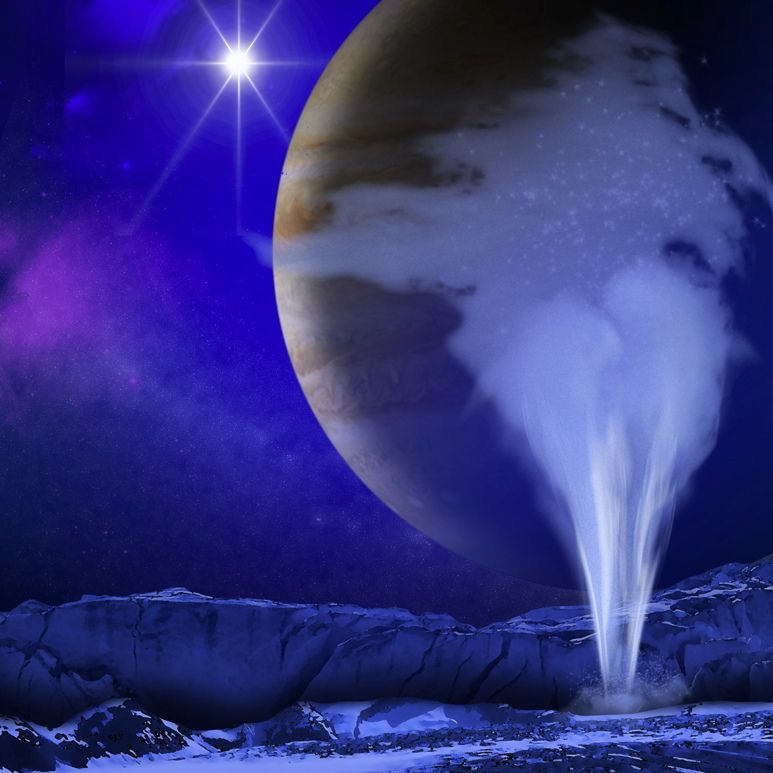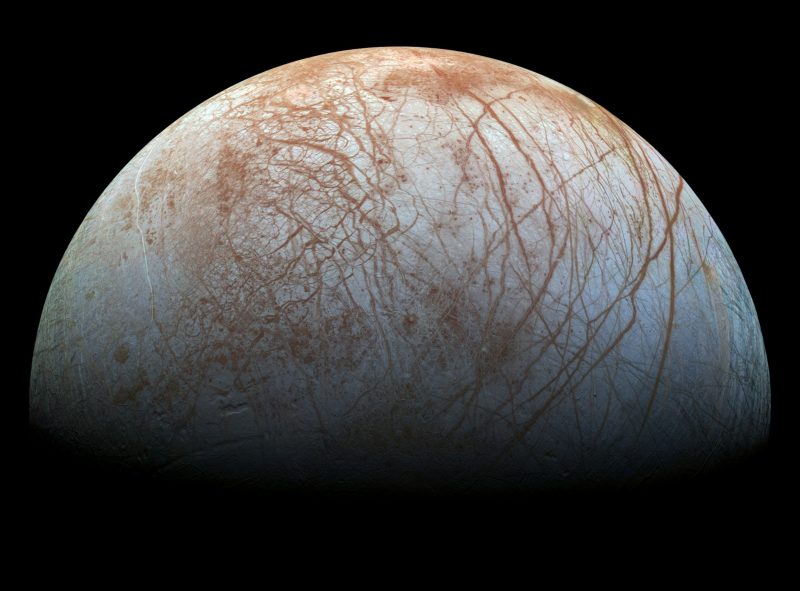
Is there life on Jupiter’s ocean moon Europa? This moon has fascinated space enthusiasts for decades, since scientists determined there’s a global ocean of water beneath the moon’s icy outer crust. Last week (June 24, 2020), NASA scientists announced new research that supports the idea that Europa’s ocean is habitable. They said this underground ocean is likely similar in many ways to the open-air oceans on Earth.
The fascinating results were presented at the Goldschmidt conference (virtual this year due to Covid-19). The associated abstract is available on the conference website. These are preliminary results, and not yet peer-reviewed.
First, the findings support what scientists had predicted about the composition of the ocean, as planetary scientist and lead researcher Mohit Melwani Daswani explained in a statement:
We were able to model the composition and physical properties of the core, silicate layer, and ocean. We find that different minerals lose water and volatiles at different depths and temperatures. We added up these volatiles that are estimated to have been lost from the interior, and found that they are consistent with the current ocean’s predicted mass, meaning that they are probably present in the ocean.

To reach this conclusion, the researchers modeled geochemical reservoirs within the interior of Europa using data from the old Galileo mission. The results are significant since they show that oceans like the one on Europa can be formed by metamorphism, that is, by a change of minerals or a distinct arrangement of minerals (a change in what geologists call texture) in preexisting rocks (protoliths) without the protolith melting into liquid magma.
On Europa, heating and increased pressure caused by early radioactive decay or later subsurface tidal movement, would have caused a breakdown of water-containing minerals. Trapped water would be released, and Europa’s underground ocean would be born.
So what about habitability?
The study also found that Europa’s ocean would have been mildly acidic at first, with high concentrations of carbon dioxide, calcium and sulfate. But over time, it became chloride-rich, resembling oceans on Earth (seawater on Earth contains 1.94% chloride). According to Daswani:
Indeed it was thought that this ocean could still be rather sulfuric, but our simulations, coupled with data from the Hubble Space Telescope, showing chloride on Europa’s surface, suggests that the water most likely became chloride rich. In other words, its composition became more like oceans on Earth. We believe that this ocean could be quite habitable for life.
Europa is one of our best chances of finding life in our own solar system. NASA’s Europa Clipper mission will launch in the next few years, and so our work aims to prepare for the mission, which will investigate Europa’s habitability. Our models lead us to think that the oceans in other moons, such as Europa’s neighbor Ganymede, and Saturn’s moon Titan, may also have formed by similar processes.
We still need to understand several points though, such as how fluids migrate through Europa’s rocky interior.

Another interesting possibility is that volcanic vents on the seafloor of Europa’s ocean might have contributed to the process of the water’s becoming chloride-rich. That would be exciting, since such vents on Earth provide heat and nutrients to a wide variety of life in our world’s deep oceans.
The Cassini spacecraft has already found evidence for such vents on the seafloor of Saturn’s moon Enceladus, which also has a global ocean beneath its icy crust.
These or other energy sources would be necessary for life to evolve and thrive in an underground ocean: a dark and sunless environment. As Steve Mojzsis, Professor of Geology at the University of Colorado Boulder, noted:
A long-standing question over whether a ‘cloaked ocean’ world like Europa could be habitable boils down to whether it can sustain a flow of electrons which might provide the energy to power life. What remains unclear is whether such icy moons could ever generate enough heat to melt rock; certainly interesting chemistry takes place within these bodies, but what reliable flow of electrons could be used by alien life to power itself in the cold, dark depths?
A key aspect that makes a world ‘habitable’ is an intrinsic ability to maintain these chemical disequilibria. Arguably, icy moons lack this ability, so this needs to be tested on any future mission to Europa.

The results of the new study are tantalizing, but more work needs to be done. How much chloride is really in Europa’s ocean? As mentioned in a June 25, 2020, article on Centauri Dreams, a paper from 2019 stated the following about sodium chloride (NaCl) on Europa:
The presence of NaCl on Europa has important implications for our understanding of the internal chemistry and its geochemical evolution through time. Whereas aqueous differentiation of chondritic material and long-term leaching from a chondritic seafloor can result in a system rich in sulfates, more extensive hydrothermal circulation, as on Earth, may lead to an NaCl-rich ocean. The plume chemistry of Enceladus, which is perhaps the best analog to Europa, suggests an NaCl-dominated ocean and a hydrothermally active seafloor. However, the compositional relationship between Europa’s ocean and its endogenous material is unknown, and the surface may simply represent the end result of a compositional stratification within the ice shell… Regardless of whether the observed NaCl directly relates to the ocean composition, its presence warrants a reevaluation of our understanding of the geochemistry of Europa.
Scientists can learn more about Europa’s ocean by modeling, but obtaining solid evidence will require actually sending a mission back there. Fortunately, NASA’s Europa Clipper mission is set to do just that, scheduled to launch in 2023.
Europa is one of the largest moons in the solar system with a diameter of 1,926 miles (3,100 km), just a little less than Earth’s moon. While the subsurface ocean is relatively warm (exact temperature not known yet), on the almost airless surface of Europa the temperatures are always a bitter minus 256 degrees Fahrenheit (minus 160 degrees Celsius) or lower.

There is also growing evidence for water vapor plumes on Europa, similar to those on Saturn’s moon Enceladus. If they are there, Europa Clipper could fly through them, just as Cassini did at Enceladus, and sample the vapor for analysis. If connected to the ocean, as Enceladus’ are thought to be, that would provide valuable clues as to conditions in the Europan ocean and, maybe, even evidence of life itself.
The latest analysis of Europa’s ocean is tantalizing, but we will know a lot more after Europa Clipper – and ESA’s Jupiter Icy Moon Explorer (JUICE) mission – take a closer look in the years ahead.
Bottom line: New study by NASA scientists shows that Europa’s ocean is habitable.
Source: Evolution of volatiles from Europa’s interior into its ocean











